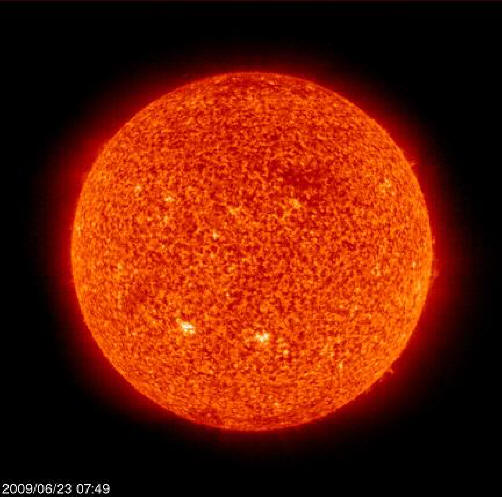|
|
Solar Electricity
Jan
28, 2010
Ideas
about the Sun based on fusion
reactions in a dense core do not fit
the observations as well as those
based on electricity.
In a recent Picture of the Day about
Solar Cycle 24 and the lack of
sunspots in a relatively quiet solar
disk, it was noted that sunspots are
not well understood by astronomers.
Furthermore, their bizarre
electromagnetic displays are not
readily explainable by models of
solar activity that rely on radiant
emissions from thermonuclear energy.
The Sun demonstrates that electrical
and magnetic properties dominate its
behavior.
Almost 70 years ago, Dr. C. E. R.
Bruce offered a new hypothesis about
the Sun. Being an electrical
researcher, as well as an
astronomer, Bruce proposed that the
Sun was a discharge phenomenon: "It is not
coincidence that the photosphere has the appearance, the temperature and
spectrum of an electric arc; it has arc characteristics because it is an
electric arc, or a large number of arcs in parallel. These arcs quickly result
in the neutralization of the accumulated space charge in their neighbourhood and
go out. They are not therefore stable discharges, but may rather be looked upon
as transient sparks. Arcs thus continually appear and disappear. It is this
coming and going which accounts for the observed granulation of the solar
surface." (A New Approach in Astrophysics and Cosmogony By
C. E. R. Bruce)
Years later, in 1972, the late Ralph
Juergens wrote a series of articles
suggesting that the Sun is not an
isolated body, but is the most
electrically active object in the
solar system—the focus of a radial
electric field extending outward
almost to the next star system.
Juergens was the first one to link
electricity in the Solar System to
the galactic circuit and to theorize
that the Sun might have an external
power source.
In the electric Sun hypothesis, the
Sun is an anode, or or positively
charged "electrode." As previously
mentioned, the cathode is an
invisible "virtual cathode," called
the heliosphere, at the farthest
limit of the Sun's coronal
discharge, billions of kilometers
from its surface. This is the double
layer that isolates the Sun's plasma
cell from the galactic plasma that
surrounds it.
In the Electric Universe model, most
of the voltage difference between
the Sun and the galaxy occurs across
the heliospheric boundary sheath.
Inside the heliopause the weak
electric field centered on the Sun
is enough to power the solar
discharge. The visible component of
the glow discharge occurs above the
solar surface in layers.
In the chromosphere, at 500
kilometers above the surface, the
coldest temperature exists: 4400
Kelvin. At the top of the
chromosphere, 2200 kilometers up,
the temperature rises to about
20,000 Kelvin. It then jumps by
hundreds of thousands of Kelvin,
slowly continuing to rise,
eventually reaching 2 million Kelvin
in the corona. The Sun's reverse
temperature gradient agrees with the
glow discharge model, but
contradicts the idea of nuclear
fusion energy trying to escape from
within the Sun.
The discovery that a "solar wind"
escapes the Sun at between 400 and
700 kilometers per second was a
surprise for the nuclear theory. In
a gravity-driven Universe, the Sun's
heat and radiation pressure are
insufficient to explain how the
particles of the solar wind
accelerate past Venus, Earth and the
rest of the planets. Since they are
not rocket powered particles, no one
expected such acceleration.
According to the electric Sun
theory, an electric field focused on
the Sun accelerates charged
particles: the faster they
accelerate, the stronger the field.
But as noted, the interplanetary
electric field is extremely weak. No
instrument would be able to measure
the voltage differential across 100
meters, but the solar wind
acceleration over tens of millions
of kilometers does confirm the Sun's
e-field, enough to sustain a drift
current across the Solar System.
Within the spatial volume, the
implied current is sufficient to
power the Sun.
In 1979, Dr. Earl Milton composed a
paper titled, The Not So Stable
Sun in which he wrote:
"In order to
maintain a stable sheath between the
photosphere and the corona a great
many electrons must flow downward
through the sheath for each ion
which passes upward. The solar gas
shows an increasing percentage of
ionized-to-neutral atoms with
altitude. Some of the rising neutral
atoms become ionized by collision.
Some fall back to the solar surface.
The rising ions ascend into the
corona where they become the solar
wind. The descending gas flows back
to the Sun between the granules—in
these channels the electrical field
is such that ions straying out from
the sides of the photospheric tufts
flow sunward, and hence the
electrons flow outward. The presence
of these channels is critical to the
maintenance of the solar discharge"
Stephen Smith
|
|
|
|
|
|
|
|
|
YouTube video, first glimpses of Episode Two in the "Symbols of an Alien Sky"
series.
|
|
|
|
|
|
|
Three ebooks in the Universe Electric series are
now available. Consistently
praised for easily understandable text and exquisite graphics.
|
|
|
|
|
|
|
|
|
|







